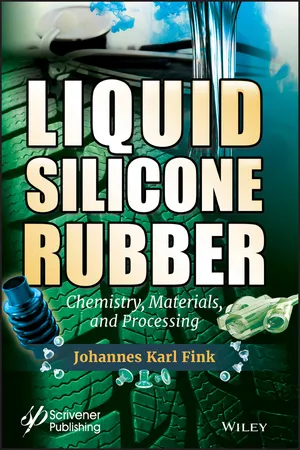1.2.1 Tracking and Erosion Resistance
Silicon rubber (SR) also offers excellent electrical performance under contaminated environments. However, a pristine silicone rubber has low thermal properties and this may cause tracking and erosion failure due to severe dry band arcing and ohmic heating on the insulating surface (7).
The effect of material thermal characteristics on the tracking and erosion resistance of silicone rubber filled with micron-sized alumina trihydrate, aluminum nitride and boron nitride particles was investigated (7). Composites with different loading were synthesized by dispersing the particles in pristine room temperature vulcanized (RTV) silicone rubber and an IEC 60587 inclined plane test (8) was conducted to evaluate tracking and erosion resistance. Apart from physical parameters and leakage current, an infrared thermal imager was used to measure the surface temperature distribution during the course of the inclined plane test. Experimental results showed tracking and erosion resistance is significantly enhanced with addition of boron nitride particles followed by alumina trihydrate.
Aluminum nitride composites exhibit a poor tracking and erosion resistance, similar to pristine silicone rubber. It has been concluded that the addition of boron nitride composites improves the ability to impede the tracking and erosion process, the reasons being better thermal stability and enhanced thermal conduction in the discharge region. On the other hand, infrared analysis revealed that thermal accumulation is remarkably higher in aluminum nitride composites, which promotes dry band arcing and results in tracking and erosion failure (7).
To improve the tracking and erosion resistance performance of addition-cure liquid silicone rubber (LSR) without alumina trihydrate, addition-cure LSR samples with different fumed silica mass fraction and platinum catalyst concentration were prepared (9).
The tracking and erosion resistance performance of the samples were evaluated. Also, the thermal decomposition products were detected. Based on the comparative analysis of thermal decomposition characteristics, the morphology, crystal structure, and improvement mechanism were assessed.
The results of this study showed that both increasing the concentration of the platinum catalyst and the mass fraction of fumed silica can improve the tracking and erosion resistance performance, whereas the former was more effective. Further analysis indicated that the platinum catalyst played a very important role in the thermal decomposition process of addition-cure LSR. Increasing the platinum catalyst content can not only promote the crosslinking reaction between the methyl groups, but also can suppress backbone decomposition (9).
1.2.1.1 Impact of Various Fillers
The influence that various fillers having different sizes, from 0.3 µm to 18 μm, and surface modifications (unmodified, modified by the material supplier and in-situ modified during compounding) have on the erosion resistance of high temperature crosslinked silicone rubber composites was analyzed. The particles used were aluminium trihydrate, alumina (Al2O3) and silica (SiO2). The main focus was on aluminium trihydrate fillers since they have the ability to release water at elevated temperature.
By a simple water storage test under defined conditions the water uptake for different composites was analyzed to assess the effectiveness of an in-situ modification. The inclined plane test according to IEC 60587 (8), and the high voltage, low current dry arc test according to IEC 61621 (10), were used to determine the erosion resistance of the different samples.
For the inclined plane test, an adapted evaluation model was applied. This test is known to have a wide scatter in the case of material formulations, which are on the borderline of passing or failing the test and therefore show substantial erosions on certain samples. The scatter could be reduced by evaluating the eroded volume by using samples only, which showed a limited erosion length. It was found for aluminium trihydrate, that larger particles show slightly better results than smaller particles. This can be explained by the formation of boehmite AlO(OH) for the larger particles, which causes a release of the bound water over a wider temperature range.
This effect could be confirmed by thermogravimetric analysis (TGA). The surface modification of the particles with vinyltrimethoxysilane and methyltrimethoxysilane, c.f. Figure 1.1, did not improve the erosion resistance significantly, but reduces the water uptake to a large extent, which is advantageous for the retention of the hydrophobicity. In order to achieve a low erosion rate, high fill...
